There’s something special about orchids – a beauty and presence that catches your eye.
Orchids are amongst the most popular flowers worldwide – at last count, there were well over over 29,000 orchid species, and over 32,000 named orchids. You’ll even find some stunning native orchids in Australia.
They are exotic, elegant, boldly coloured, absolutely unique, and the picture of perfection. They are your pop of colour and beauty on a rainy day, sweet scent on a warm summer evening, and for some, a happy reminder of a tropical holiday.
Best of all, many orchids are also readily available and easy to care for indoors or outdoors. So let’s get potting, spritzing, and creating.
Before you put on your gardening gloves
We had great fun finding the most exquisite orchids for you. And while their scientific names are sometimes a bit hard to pronounce, at least there’s only one per orchid.
Not so when it comes to common names; they seem to differ from region to region.
So in this article to save you and ourselves a lot of confusion, we’ve highlighted the scientific name first and foremost. Where we’ve not indicated a common name, we likely found more than one.
Please also remember that in this article, we’ve concentrated on orchid genera or orchid families. This is because individual species within each family of orchids are as varied as the colours of the rainbow and the climates and natural habitats they come from.
Our team at Flowers Across Melbourne gets frequent questions on how to best care for an orchid. So we’ve gathered the most common ones, with a special focus on conditions in Australia.
Orchids are native to many parts of this world and are home across a broad range of climate conditions. However did you know that native orchids in Australia are protected? It is illegal to collect them from the wild! Unfortunately most of the time picking them results in the plant dying. This is because they are not easy to cultivate. Many species have only a small population left in the wild as well.
We have created Care instructions to cover the majority of species within a genus and conditions in Australia, but it’s always best to follow the instructions that come with your plant. Enjoy!
Around the world in 27 orchids
Scientific Name: Phalaenopsis (fail-eh-NOP-sis)
Common Name: Moth Orchid

We feel the name doesn’t do this most popular of potted orchids justice. Not only are Phalaenopsis beautiful, but they are also some of the easiest and most rewarding plants to adorn a room. The best-known classic white Phalaenopsis is always an elegant showstopper commanding attention. But of course, these orchids come in many striking colours and are readily available year-round. ABC has produced a great guide as part of their Gardening Australia series, but here’s a summary of the main points
Caring for your Phalaenopsis
- Light and Temperature: Phalaenopsis like bright but not direct sunlight.
- Water: Moth Orchids like humidity and some airflow (not a draft though). One way to create the perfect micro-climate for them is to stand them on a tray of pebbles filled with water.
- Potting/planting: A bark-based orchid potting mix in a plastic container is perfect – as long as there are enough drainage holes and loose matter so that the roots don’t sit in water – one of the most common issues is root rot! Phalaenopsis are an epiphytic plant so will likely have aerial roots growing over the top of your pot. That is totally ok, it’s their way of searching for moisture.
Blooming
You might be tempted to replace your Phalaenopsis with a new one once the blooms fall off, but with a bit of care, this trooper will flower again and again, with good care twice a year. Blooming is almost always triggered by a temperature change. You can prune a flower spike so that only two nodes remain if it is still partially green. But it is generally recommended to cut the stem completely – definitely once it’s yellow or brown. That way, you’re allowing the plant to shift to its vegetative cycle, then put its energy into growing a brand spanking new stem. Some additional tips are to not force the orchid to rebloom from the same spike if there are fewer than four leaves. Lastly most Phalaenopsis you buy are tightly packed in spaghnum moss, so don’t be afraid to repot them when you buy them! Spaghnum moss is hard to re-wet when it dries out and also can stay too wet, leading to root rot.
Scientific Name: Cymbidium (sim-BID-ee-um)
Common Name: Boat Orchid

Boat orchids are among the oldest in the world. Their earliest mention dates back to the Jin Dynasty, around 200 BCE! Native to Southeast Asia, these stunners are spread primarily across tropical and subtropical Asia, but also in Australia.
Many of these large-flowered varieties can grow at high altitudes – even in the Himalayas. This means they need a pronounced cool period to flower but are also far more cool-tolerant than many other orchids. These orchids can take full sun in winter but need protection in summer.
Caring for your Cymbidium
- Light and Temperature: Full morning sun or light shade works best.
- Water: Cymbidiums like to be watered well during their growing season and need lightly moist soil when flowering. Tap water is usually fine, but as with all orchids, the purer the water, the better!
- Potting/planting: These orchids are rich and loose and naturally do well in loamy humus – you can easily replicate these conditions at home. Use a common orchid mix or an organic orchid mix such as bark or perlite that is rich and loose, combined with fir bark or peat moss, for example. A bimonthly feed with orchid fertilizer or slow-release pellets during the growing phase is all they need. An economic way to pot these orchids is to use a 50:50 mix of orchid mix and a coarse perlite, which will help keep the mix open (allowing the roots to access oxygen) as well as retaining moisture so that they don’t dehydrate. Repotting is best done in Spring when there is new growth (during or after flowering). A slow-release fertiliser is best applied in late winter/early spring too. An excellent plant for your garden in the Melbourne region!
Blooming
Boat Orchids brighten a grey day from mid-autumn to mid-spring with beautiful sprays of large blossoms in white, pink, yellow, and green. Plants can get up to 60 – 70 cm tall.
Scientific Name: Dendrobium (Den-DRO-bee-um)
Common Name: n/a
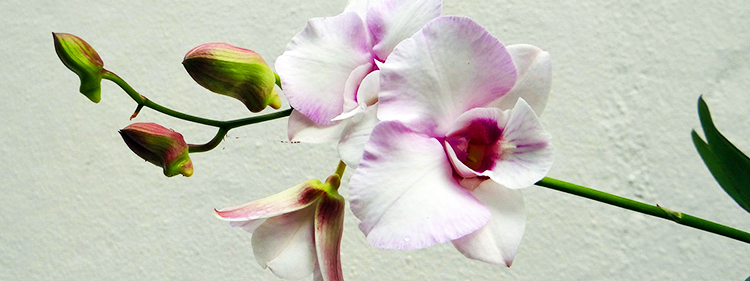
This is a hugely diverse group of orchids. Most Dendrobium species are native to Southern Asia, but a few originate in the Pacific Islands and Australia. Although there doesn’t seem to be a name for the genus itself, the better known of its almost 1000 species have wonderful common names such as Cucumber Orchid, the Bull, or the Pigeon Orchid. However, don’t be fooled by their dainty appearance; these are tough plants. Please note that these differences in species means their care will also be vastly different. Dendobriums can be split into soft canes, hard canes and Australian natives. Here, we’ve concentrated on Australian natives.
Caring for your Dendrobium
- Light and Temperature: Even amongst the Dendobriums native to Australia, there are huge differences when caring for them. Whilst most are considered cold growing, some will do best in a heated glasshouse. The one thing they all seem to have in common is the need for a rest period in winter and good light throughout.
- Water: There’s no one rule fits all for watering. It depends on species, positioning, and airflow. Make sure you don’t over-water. A free-draining potting mix with added pebbles and bark will address the needs of most plants in this species.
- Potting/planting: The native Australian Dendrobium seems to flower more profusely when squeezed into a pot. Place it in a well-ventilated spot to keep leaves cool. A potting mix with pine bark is said to work best and repotting is needed once the plant outgrows its pot.
Blooming
The flowering season for the Australian natives is usually from August to October. These plants will delight with masses of delicate orchid flowers in various glorious colours. Some of them are very sweetly perfumed.
Scientific Name: Paphiopedilum (paff-ee-oh-PED-ih-lum )
Common Name: Slipper Orchid

One of the most widely cultivated orchids, highly coveted amongst collectors, this is a striking and tantalising ‘look at me’ orchid. There’s even a Facebook group in Australia, for those interested in the art, science, cultivation, and appreciation of Slipper Orchids.
Caring for your Paphiopedilum
- Light and Temperature: Slipper Orchids can be grown indoors, but for that to be successful, they’ll need conditions that mimic their natural habitat. This means 50 to 70 % humidity, moderate temperatures (13 to 35 °C), and low light.
- Water: Water well until it runs through the drain holes in your pot but only just before the potting mix is completely dry. They don’t like to be water-logged.
- Potting/planting: Modern hybrids are generally easier to grow. First, make sure you use the right-sized pot. Roots are fleshy and thick and, when potted, form a tight lump. Using a porous soil mix, made up of fir bark, peat, charcoal, and extra coarse sponge rock is recommended. Except during the hot summer months, fertilise with a liquid formula the day after every second watering.
Blooming
Paphiopedilums come in striking patterns and a myriad of gorgeous colours, from red to brown, to pink, a light yellow, and orange to peach. Flowers can last for up to 8 weeks.
Scientific Name: Cattleya (CAT-lee-ah )
Common Name: Cattleya
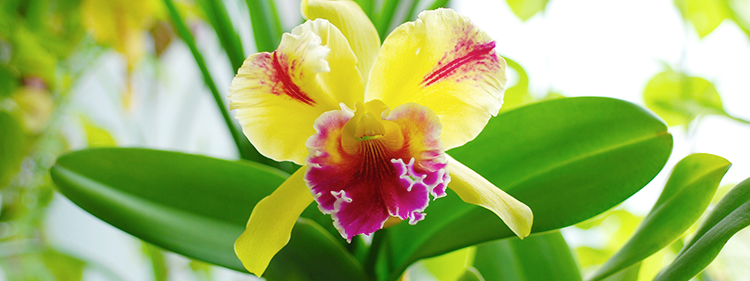
Often referred to as the Queen of Orchids, Cattleyas are an easy-to-grow, showy number. Although they’re named after an Englishman – British botanist William Cattley, their origins are in South and Central America. Their striking blooms have been used for ceremonies long before the arrival of any explorers.
Caring for your Cattleya
- Light and Temperature: Morning sun seems to work best for Cattleyas. Intense midday and afternoon sunlight will burn their leaves.
- Water: Water well, but let the plant dry out before the next watering. A regular feed with an orchid booster, especially before flowering, will also not go amiss. Finally, add some bark or charcoal to the bottom of your container.
- Potting/planting: Ideal growing conditions would be hanging in a basket in reasonable humidity in a glass house. Of course, many of us don’t happen to have one handy; but a semi-shady porch or patio that doesn’t catch too much wind will work just as well – and there’s always the indoors option. Cattleyas do well in pots or baskets. Replant them once they start to outgrow their pot. Then, either transfer to a bigger container or divide the bulbs. If you do that, ensure you always have three bulbs in a clump, one lead bulb, and two behind it.
Blooming
Don’t water the blossoms directly and keep them out of the wind. If you find the right spot and growing conditions, you will be rewarded every year with beautiful, fragrant flowers that come in an abundance of spectacular colours and patterns. The colour palette ranges from pink, orange, purple, and red to yellow and white, even blue. Some hybrids will even produce flowers more than once a year.
Scientific Name: Laelia (lay-LEE-ah)
Common Name: N/a
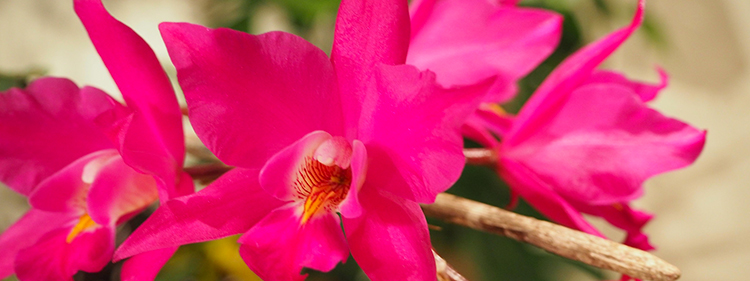
Admired for their beauty, the Laelia was named after one of the Vestal Virgins. Laelias are native to Central and South America, from Mexico through to Brazil. They can be found in altitudes of up to 2000 metres but also in coastal, and lower regions. This means they can be grown outdoors in some climate zones.
Caring for your Laelia
- Light and Temperature: Hailing mostly from higher altitudes, Laelias like cooler winters and generally a temperate climate. They don’t need high humidity and prefer bright but filtered light, which makes them relatively easy to grow. Make sure they don’t sit in direct sunlight.
- Water: Water them regularly during the growing season, otherwise, they’re ok to dry a little. Use a liquid seaweed fertiliser twice a month during their growth phase.
- Potting/planting: The larger growing plants can be grown in containers, the smaller types do better mounted. Whichever you choose though, make sure drainage is good.
Blooming
These lovelies will flower from autumn through to winter, some species even flower throughout the year. They will show off vibrant pinks and fuchsias and some lovely shades of orange and peach.
Scientific Name: Brassavola (bra-sah-VOH-lah)
Common Name: N/A
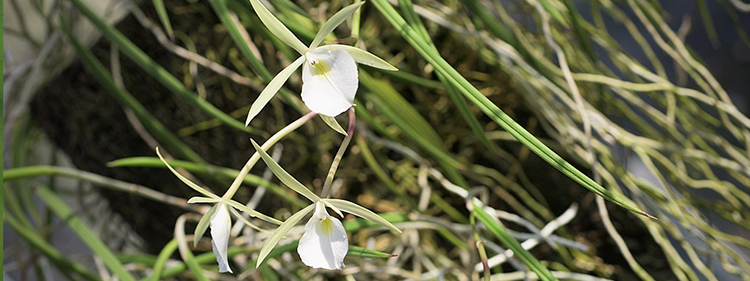
Brassavolas are immensely popular with budding and die-hard orchid lovers named after an Italian Botanist. They are relatively easy to care for and produce delightful, often scented flowers in all colours of the rainbow.
Caring for your Brassavola Orchid
- Light and Temperature: These orchids typically like quite bright light, even some direct sunlight, and temperatures at the warmer end of the scale. A healthy Brassavola has slight reddish marks on the leaves. Deep green leaves usually mean the plant does not get enough sunlight.
- Water: Brassavolas are more drought tolerant than many other orchids. How often you water them depends primarily on their environment. Still, as a rule of thumb, they need plenty of well-draining water and high humidity: (40 – 70%) during their active phase and less after their growth period. If leaves start to wrinkle and droop, they will need more water. In addition, they’ll need a constant but low dose of fertiliser year round.
- Potting/planting: This genus will thrive in baskets or on mounted fern plaques. A Brassavola grows quite quickly. Plants are easy to divide, so don’t bother with repotting them. You’ll have the added bonus of increasing your orchid collection rapidly or surprise your friends with a lovely orchid gift. If potted in a container, use a good, fast-draining orchid mix and add some charcoal and pine bark chips.
Blooming
These mostly white and green lovelies are year-round bloomers, and their slightly citrussy scent on a warm summer’s night is always a real treat.
Scientific Name: Encyclia (en-SIK-lee-ah)
Common Name: n/a
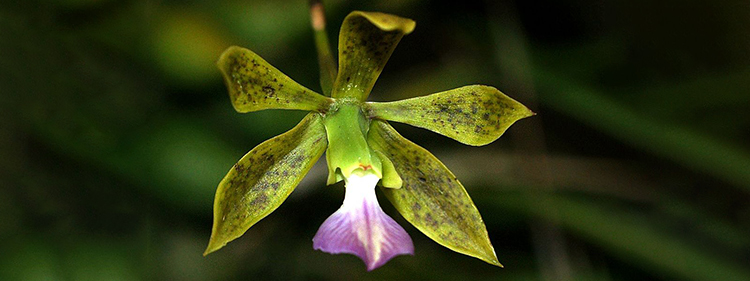
The well over a hundred species belonging to the Encyclia genus are really varied, and so are their needs. They can range in size from a couple of centimetres to half a meter. Native to the Caribbean, their distribution is equally wide these days, from Florida in the north to Argentina in the south.
Caring for your Encyclia
- Light and Temperature: Coming from a tropical climate, most Encyclia like a warm spot and do well in bright, indirect light and good humidity.
- Water: Check watering instructions for your specific species. These orchids are native to damp, warm forests and are used to absorb moisture and nutrients from water and air. A little spritz of water and putting your pot on a bed of pebbles to simulate that environment will work well. Be careful not to overwater them.
- Potting/planting: Encyclia will do well potted in a particularly well-draining mix such as river rocks, charcoal, or fir bark. Grow your orchid supply by dividing your plant into parts of four stems. Remove any dead roots, set your division aside, and new growth will likely appear a week later. That’s when you can repot your new plant and start it off in slightly lower light.
Blooming
Encyclia will brighten your spring with dazzling blossoms in showy purples, browns, yellows, greens, and fuchsias. They will make lovely presents if you can divide your plant. Plus, as a bonus, some of them are scented.
Scientific Name: Oncidium (on-SID-dee-um)
Common Name: Dancing Lady

Dancing Lady! What an apt name for this orchid genus! Most Oncidium blossom in sprays on multiple, seriously long stems in all shades of yellow and brown. Perhaps a bit like a line-up of dazzling dancers with swirling gowns in a Broadway show. This genus is a close ally to Odontoglossum and can be easily hybridised.
Caring for your Oncidium
- Light and Temperature: Dancing Ladys are really hardy plants. Originally from Central and South America, they grow from coastal regions to high up in the Andes. They will do well in shaded and bright spots but without direct sunlight. In Australia, many Oncidium varieties prefer to stay indoors.
- Water: During the warmer months of the year, water them almost daily, then dial watering right down during winter. As a rule of thumb, if the roots are green, the plant is in its growth phase and needs fertiliser and water.
- Potting/planting: Most Oncidium orchids are epiphytes, which means they will thrive on rocks, bark, or perched on a tree branch, for example. Plants will do well in a smallish container compared to their size. Choose a free draining mix with added fine bark and repot them every two years, once new roots are starting to appear at the base of a new shoot.
Blooming
Dancing Ladies are often scented and bloom mostly in autumn and winter. You’ll see them most often in shades of yellows and browns. However, new species in stunning white, red, green, pink, and purple are also starting to emerge. They can grow seriously high, most up to 3 metres, so make sure you’re giving them support especially when they’re in bloom!
Scientific Name: Odontoglossum (oh-dont-oh-GLOS-um )
Common Name: n/a
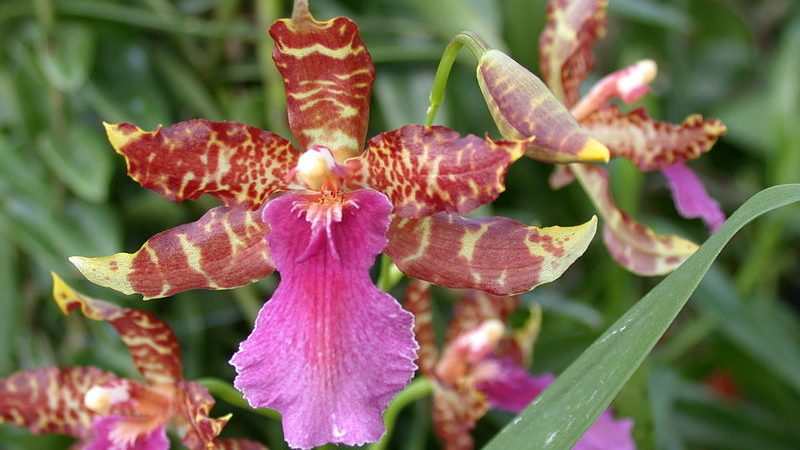
You might think Odontoglossums are something you’d find at the dentist. But no, these beauties are some of the showiest, grand orchids amongst orchids! Habitats and species vary greatly, though, so many care instructions depend on which orchid you choose. For the die-hard Odontoglossum fans, the Orchids Council of Victoria offers a detailed culture sheet. These orchids can be easily hybridised with Oncidium, Miltonia or Brassia. Taxonomic revisions have moved many species into the Oncidium genus, but the debate is still raging and readers may find plants under either name! Many of the hybrid genera start with the prefix Onc- and many of these intergeneric hybrids come in a dazzling array of colours (particularly the former Wilsonara genus and others like Aliceara). There’s also good culture guide on the AOS website for the genus that you can use as a reference: https://www.aos.org/orchids/culture-sheets/oncidium.aspx
Caring for your Odontoglossum
- Light and Temperature: Generally, growing conditions need to be cool to very cool. Odontoglossums typically need plenty of light in winter, early spring, and autumn but not direct sunlight. Stuffy hot houses are the wrong place for them. They will typically not grow well if the temperature regularly goes above 16C.
- Water: As long as you don’t overwater or let them run dry, your plants should be fine. Treat them with a regular spray of water or a mister, especially on a hot day.
- Potting/planting: It is recommended to repot these orchids once a year and use a potting mix with added pine bark topped with spaghnum moss for best results.
Blooming
The trick here is to pick the flowers before they are completely spent. Do this and find the right spot, and you will be rewarded with stunning flowers with remarkable patterns and striking colours.
Scientific Name: Miltonia (Mil-TONE-ee-ah)
Common Name: Pansy Orchid
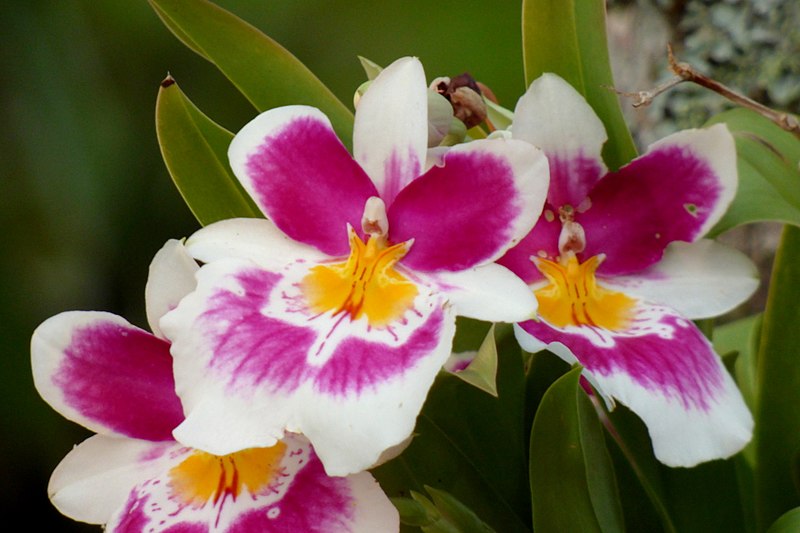
What an excellent indoor plant Miltonias make! Their attractive flowers often impress with their intrinsic patterns and are generally long-lasting. Originally found in the high mountains of South America, mainly Brazil, these orchids are relatively easy to care for, definitely not fussy, and always stunning.
Caring for your Miltonia
- Light and Temperature: Miltonias like a bit of morning sun; otherwise, filtered light will work best. Keep them at room temperature in a spot with good ventilation. If the foliage starts to turn very dark, your plant doesn’t get enough light!
- Water: These orchids need plenty of water, and fortnightly flushing with water at room temperature is recommended. They should never completely dry out. Again, pebbles underneath the pot will help with the necessary humidity. Add a general orchid fertiliser once a month.
- Potting/planting: Pot your Pansy Orchid in a mixture of sphagnum moss and fine bark. Use more bark in humid environments and more moss for drier and hotter climates. Repot them once a year, ideally in spring when the new shoots start to show.
Blooming
Orchid Pansies seem to do their own thing here; they flower when they’re good and ready, not during a particular season. We do like the many amazing shades of purples, pinks, and fuchsias, but their striking patterns really set them apart.
Scientific Name: Cambria
Common Name: n/a

In actual fact, Cambria is neither the scientific nor the common orchid name but a commercial one. Cambria is not a clearly defined genus in its own right but a group of hybrids resulting from crossbreeding efforts. These orchids are not to be sneezed at though. Not only are they beautiful and brightly coloured, but they’ve also inherited all the good traits of their ancestors. They need little attention and are the perfect orchid for beginners.
Caring for your Cambria
- Light and Temperature: These instructions will be short and easy. All you need to do is keep your Cambria in a place with good light and lightly humid air but away from direct sunlight. Keep the plant in a cooler room during the dormancy period.
- Water: Water evenly once a week or before the soil is completely dry. It’s easiest to submerge the whole pot in water to soak. Reduce watering during the orchid’s dormant phase and use fertiliser only once the first spike emerges.
- Potting/planting: Don’t worry too much about arial roots overflowing from your pot. You can replant your orchid easily once the flowers have all gone. Just take the entire plant out of its pot and remove any brown roots before putting it into a larger pot.
Blooming
Cambria can grow up to half a meter in height! So enjoy its brightly coloured, speckled blooms from autumn through early spring. Applying a tomato fertiliser during their bloom is said to be really effective!
Scientific Name: Zygopetalum (zy-go-PET-a-lum)
Common Name: n/a
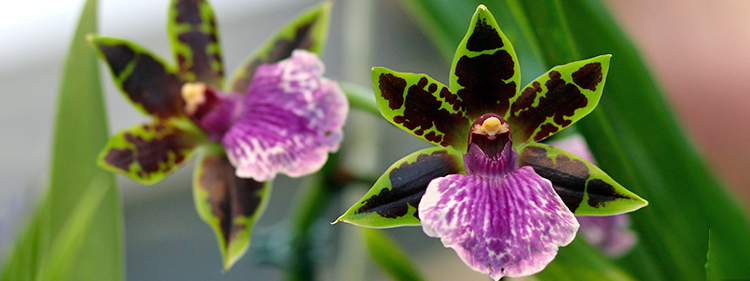
Zygopetalums are not the showiest orchids, but we are sure you’ll love them for their heady scents. They are native to South America; most of their species grow in Brazil. These orchids grow in cooler rainforest environments and will flower profusely when looked after well.
Caring for your Zygopetalum
- Light and Temperature: Many of these orchids will tolerate light frosts but will flower better in slightly warmer conditions. Direct light early or late in the day will be fine.
- Water: Make sure your orchids are almost dry before the next watering and boost them regularly with a dose of liquid fertiliser. They will need to be kept much drier during the cooler months.
- Potting/planting: Quite intolerant of poorly drained or soggy potting mixes, they are happiest in shallow pots. They typically can also adapt to baskets or fern slabs. Use a good orchid mix with added Sphagnum moss. Your moss should always be at the bottom of the container.
The roots are generally quite delicate, which makes division a bit harder.
Blooming
Peak growth time is during spring and summer; flower spikes can grow up to 60 cm. Most flower twice a year, some even four times and for as much as a month. Get your growing conditions right, find just the right spot, and you will be rewarded with lovely blooms and sweet scents.
Scientific Name: Bulbophyllum (bulb-oh-FILL-um)
Common Name: n/a
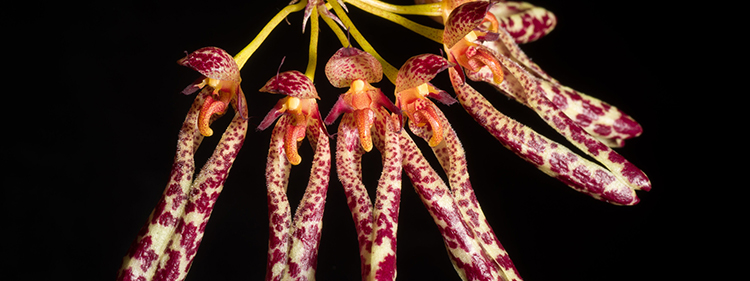
This is considered one of the largest genera of orchids, with over 2000 species spread across all warmer regions of the planet; Papua New Guinea alone is said to host 600, though. With such diverse habitats comes a diverse range of blooms and care instructions. Its species are sometimes bizarre but always fabulous; some have been the envy of collectors for well over 100 years.
Caring for your Bulbophyllum
- Light and Temperature: High humidity together with good air movement is essential. These orchids tend to do best in low, shady light but not complete shade, with a bit of morning sun thrown in for good measure. In addition, they need a relatively constant warm temperature, 20 to 30 °C during the day and 16 – 18 °C at night.
- Water: They can tolerate a short dry period but should always be kept moist.
- Potting/planting: Except for some of the smaller species, they are not the easiest pot plants and will do better in a sheltered, shady spot in the garden, depending on your climate.
Blooming
Most species flower all year round – they can be your guaranteed daily pop of colour! Many of them are scented, but beware! Some species in this genus are known to produce a repelling smell and not the sweet scent you’d hope for!
Scientific Name: Coelogyne (see-LODGE-eh-nee)
Common Name: Necklace Orchid
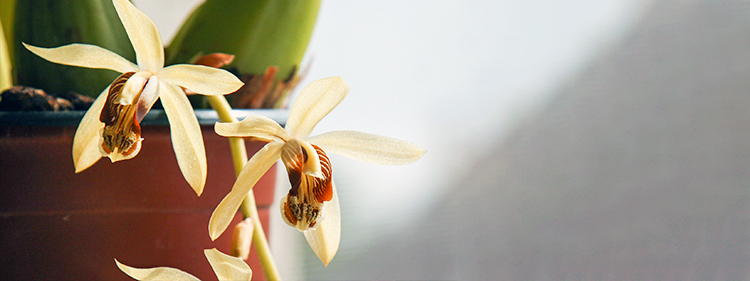
Very undeservedly overlooked by the public, these gorgeous, long-living, mostly large flowering, fragrant orchids have been popular with collectors for some years. Hybrids are finally starting to appear in nurseries.
Caring for your Coelogyne
- Light and Temperature: Native to the southern parts of Asia through to the Philippines and New Guinea, these orchids thrive in humidity, filtered light, and air circulation. They do well in warm to cool climates and need a cool spell in winter.
- Water: As with many orchids, they like to be moist but never water-logged. They’ll need less watering during the cooler months. You can give them a fertiliser boost once a month, year-round.
- Potting/planting: With so many different species, you’ll find some like hanging baskets, others are happiest in a pot and some will prefer to be ground mounted, onto fern slabs for example. You can repot every 2 to 3 years at the latest, once their flowering season is over.
Blooming
These orchids are a true delight. Some impress with clusters of fragrant snow-white or single pink/peach flowers. Others show off chainlike racemes (hence the name Necklace Orchid) of chocolate and topaz-coloured, emerald and blue flowers or spice-scented, delicate white blossoms. Most species will bloom in spring or winter. Enjoy!
Scientific Name: Masdevallia (maz-deh-VAL-ee-ah)
Common Name: n/a
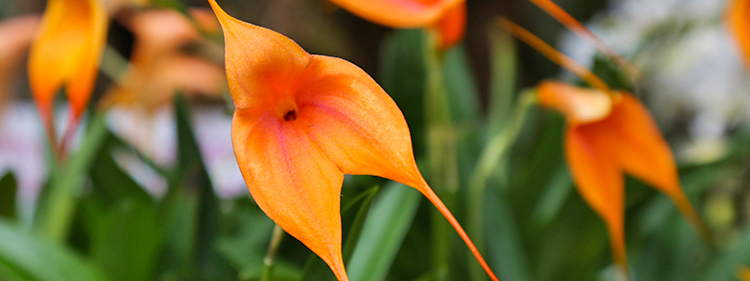
Named in honour of the Spanish botanist and physician José Masdeval in 1794, this is another spectacular orchid family. Masdevallias are native to South America and some of its species landed ‘interesting’ locally relevant names. Imagine being called Wagangki tree, a name the Incas gave, which translates to ‘You will cry’! Other common and slightly unflattering names for Masdevallia species are ‘Frog’s skin’, ‘Eggs of a bird’, and ‘Chicken foot’.
Caring for your Masdevallia
- Light and Temperature: These orchids are generally cool growers; keep them shaded in summer to keep the plant cool. They love an environment that has plenty of air movement.
- Water: Masdevallias have somewhat delicate roots and like to be in moist soil. But again, don’t overwater and don’t let them sit in water, otherwise, their roots will rot. If you grow them indoors, you must regularly mist the leaves.
- Potting/planting: They do well in net pots with moss, as long as you don’t let the soil dry out and leave air pockets. Only repot them when they are quite large.
Blooming
Masdevallias are your little pocket rockets. They are compact, so they don’t need much space. Flower spikes usually produce one flower, but blooms come in all colours of the rainbow and range from pale to almost neon brightness.
Scientific Name: Vanda (VAN-dah )
Common Name: n/a
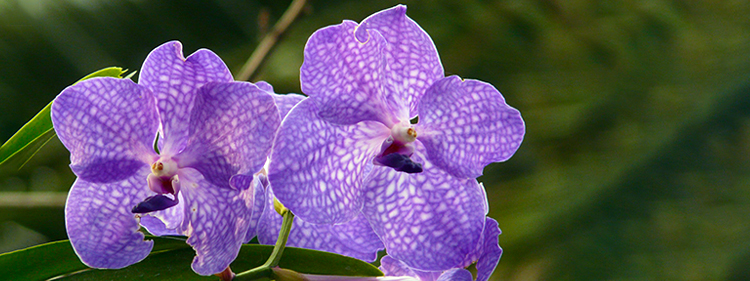
Widely spread from India to Australia, these popular orchids are happiest in lots of bright light, warm temperatures, high humidity, and plenty of water. They like their roots to just dangle in a light breeze. In their native habitat, Vanda orchids hang from trees or cling to clifftop cracks. If looked after well, they will bloom several times a year!
Caring for your Vanda
- Light and Temperature: Most Vanda orchids need bright light but will not do well with the direct midday sun. Most of these warm-blooded blooms do best in high humidity during the warmer months and all-year temperatures between 22 °C and 31 °C; we think parts of coastal Queensland and the Northern Territory will be perfect. Make the Vanda orchid your houseplant everywhere else – it is definitely not cold tolerant.
- Water: Vandas will need heavy daily watering and a maintained high humidity. They are used to heavy Monsoons, after all! You can reduce watering in cooler months. Their roots should never sit directly in water.
- Potting/planting: These orchids do best in hanging baskets with little organic matter. Their roots gather moisture from the air and just need something to cling to, a little perch. Give them a weekly dose of fertiliser during their growing season. Try to repot/disturb the plant as rarely as possible, every 3 to 5 years.
Blooming
Once you’ve got the right conditions for your Vanda Orchid, you’ll be rewarded with magnificent blooms every few months. Its flowers are often used for leis and come in many intense colours, often with speckled petals. The plant has thick glossy leaves and can get up to 1 m tall, depending on the species.
Scientific Name: Psychopsis (sye-COP-siss )
Common Name: Butterfly Orchid
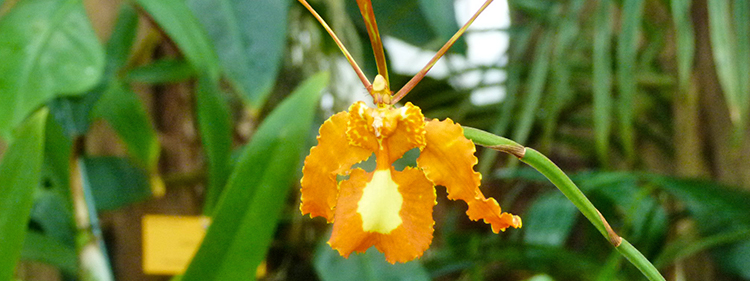
These are some of the daintiest orchids with light and brightly coloured blooms as butterflies. Only five recognised species are in this group and all hail from Central/South America. These delicate yet hardy orchids deserve a place in the sun.
Caring for your Psychopsis
- Light and Temperature: Native to rainforests, this genus likes bright but indirect light, consistent humidity and reasonable air movement. It will not tolerate stale conditions.
- Water: Butterfly Orchids will do well with frequent and abundant watering, and flushing out with water – as long as they are allowed to dry out almost completely first and are never waterlogged. Regularly apply a balanced fertiliser.
- Potting/planting: Butterfly Orchids will need a light bark mix and you should repot them at least every 2 – 3 years.
Blooming
These striking orchid flower blooms in yellows, orange, pink and red impress with their form. Their butterfly shape tricks male insects into mating! Mind you, this deception is used by many other orchids as well.
Their bloom time varies dependent on the species.
Scientific Name: Maxillaria (max-ih-LARE-ee-ah)
Common Name: Spider Orchid
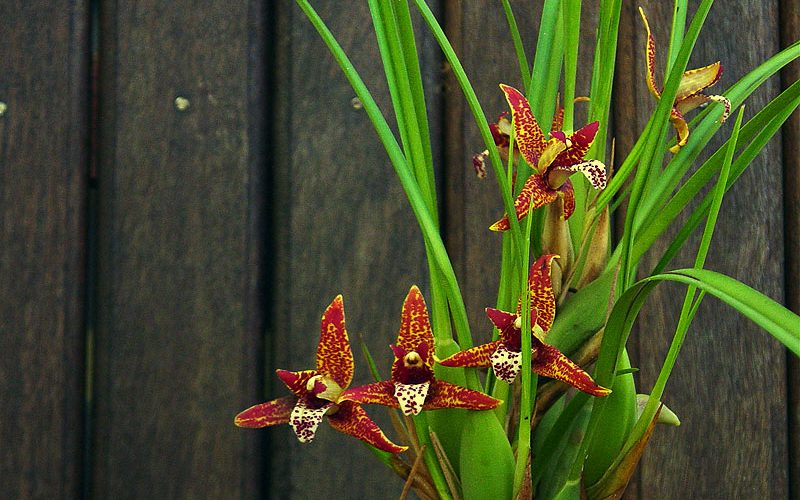
This genus is distributed throughout Central America, from Florida to northern Argentina, and is one of the most widespread New World orchids. Not surprisingly, species vary considerably.
Caring for your Maxillaria
- Light and Temperature: Maxillarias will do best in good, filtered light, but never in direct sunshine; they will need more light in winter. Temperatures depend on the particular species, but generally, they will need lower temperatures at night.
- Water: Water them regularly in a free-draining potting mix, but never leave them with soggy roots or completely dry. They’ll need less water in winter. Over summer, they’ll benefit from a good orchid fertiliser once a week.
- Potting/planting: A good, well-draining potting mix with added bark or moss will be best. Only repot your plant when new growth AND new roots are visible.
Blooming
Maxillaria produce attractive flowers in white to brown, mixed through with reds and purples, and some of them are scented as well (check out the Coconut Orchid!). They come in all sizes but will always produce a single flower per stem.
Scientific Name: Angraecum (an-GRAY-cum)
Common Name: Comet Orchid
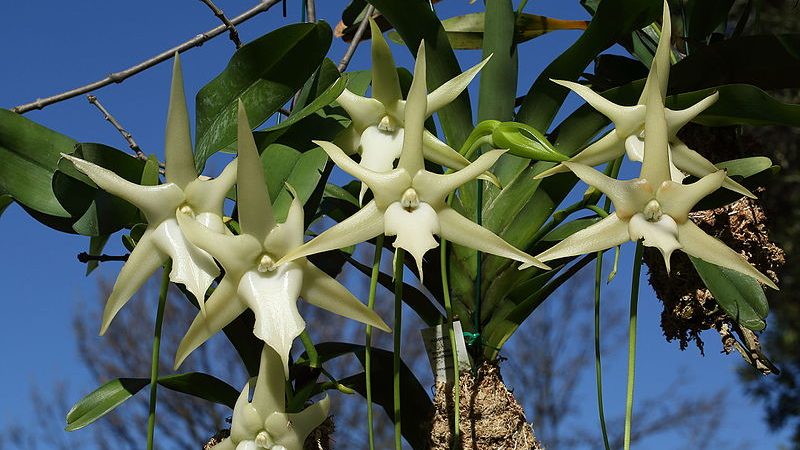
These often star-shaped beauties in shades of white and green are native to Africa. The best-known one is perhaps the regal Christmas Orchid. However, many species of the Comet Orchid are protected from international trade as they are sadly threatened by extinction in the wild. At risk from overcollection and loss of pollinators, many species are a top conservation priority, particularly the ones endemic to Madagascar.
Caring for your orchid
- Light and Temperature: Both depend on the natural habitat your orchid is coming from. It’ll be a warm to an intermediate temperature, with the cooler growing species liking more shade than the ones naturally growing in warmer regions.
- Water: Feeding very much depends on the species. The cooler growing species generally get away with less water than the ones needing warmer conditions. A monthly dose of fertiliser is recommended.
- Potting/planting: The bigger species will do well in a pot with a suitable orchid and bark mixture, whereas the smaller species will do better mounted on a slab to mimic their national habitat.
Blooming
Comet Orchids can usually flower all year round; many are scented and nocturnal. Imagine enjoying a warm summer evening on your veranda with the scent of your orchid wafting through the air!
Scientific Name: Catasetum (cat-a-SEE-tum)
Common Name: n/a
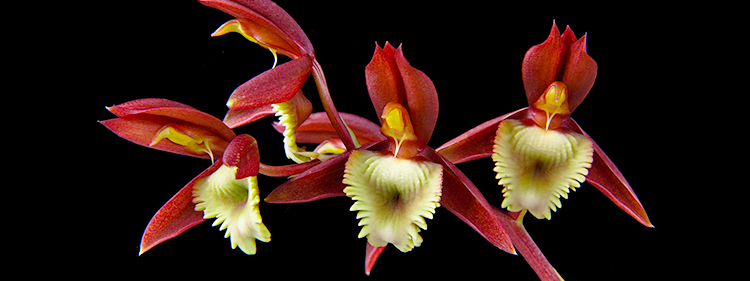
When it comes to the common name of the Catasetum orchid – Monkey’s Goblet or Monk’s Head – opinion is clearly divided as to what they look like and how people perceive them! However, all of these orchids are exotic-looking showstoppers! What do you see? What does their flower remind you of?
Caring for your Catasetum
- Light and Temperature: Catasetums can tolerate some open sun. They like bright, open light with minimal shade and good air movement.
- Water: Water regularly and maintain high humidity when the flowers are growing. Once they have developed, you can dial the watering right down and you don’t water them in winter. Give them a boost of fertiliser throughout their growing phase, but water and airflow are the crucial factors to successfully growing your orchid.
- Potting/planting: In their native habitat, many Catasetum grow in the warm, moist open canopy of trees, with a small number found on rocks or in the “boot” of palm trees. Hanging baskets, suspended pots, or mounting them will best mimic their natural environment; as long as you water them well.
Annual repotting is recommended.
Blooming
Interestingly, and rather uniquely, the colouring of these orchids is based on sex. Male plants are the most colourful ones and develop in more shaded areas, whereas female flowers tend to be yellowish-green and grow in a brighter light!
Terrestrial Orchids
Scientific Name: Bletilla (bleh-TILL-ah)
Common Name: Urn orchid
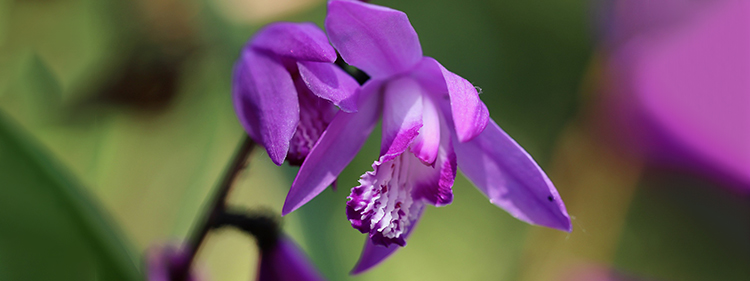
Don’t be fooled by their rather bland common name. Bletilla is a small genus of rather lovely and very hardy orchids. Unfortunately, there are only about eight species, and of those, you’re likely to find only one in your local nursery, the award-winning, gorgeous Bletilla Striata.
Caring for your Bletilla
- Light and Temperature: Grow them in a spot with morning sun and afternoon shade.
- Water: Water your Bletilla when the soil is almost dry, but never over-water.
- Potting/planting: This is an excellent plant for pots and containers and, in most regions, will look equally fab as a border plant in the garden. Make sure the soil is well-draining.
This genus also produces generous clumps that can easily be divided.
Blooming
Bletilla Striata is a terrestrial and deciduous orchid. It produces small, exotic-looking purple-pinkish flowers, up to 12 per stem. It will bloom in mid to late spring for about six weeks.
Scientific Name: Pleione (plee-OH-nee )
Common Name: Indian Crocus
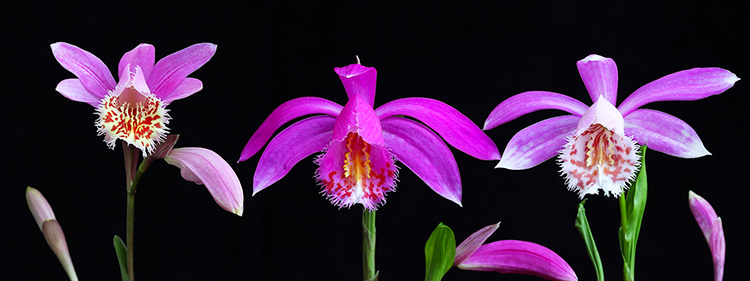
Pleiones are our ‘under-promise, over-deliver plants. Their striking flowers almost seem too large for these miniature plants. The British gave them the name Windowsill Crocus as they are so easy to grow indoors.
Caring for your Pleione
- Light and Temperature: This genus typically prefers cooler temperatures and like plenty of shade.
- Water: Orchid experts recommend watering them at night once the temperature has dropped. They will need little water during dormancy in autumn/winter. Feed them with a potassium-rich fertiliser once a month during their growth period. Seaweed fertiliser is perfect for these hungry feeders.
- Potting/planting: They do well in deep pots with good drainage but can also be grown outside, depending on where you live. If you do pop them in your garden, make sure you protect them from slugs and rain. You can carefully remove the plants after flowering, clean them, and get rid of dead leaves. Place the bulbs in a ziplock bag and keep them in your fridge’s crisper until spring.
Blooming
Most Pleiones flower in spring and come in many colours, from white to green, to pink, mauve, red and purple. An easy plant to brighten up any space!
Scientific Name: Phaius (FAY-us)
Common Name: Swamp Orchid
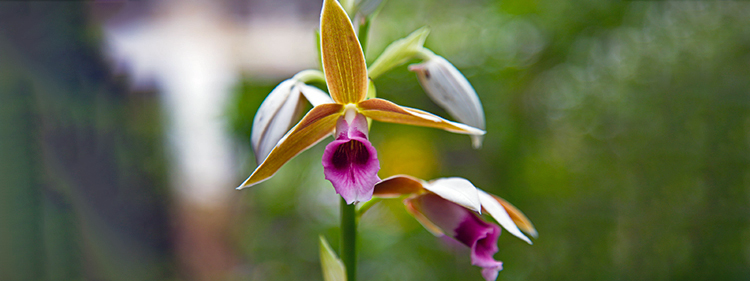
There are currently 45 species belonging to the genus Phaius, widespread across tropical and subtropical regions. Two species are endemic to Australia!
The Phaius Australis is one of Australia’s largest terrestrial orchids and can easily grow to 1.2 metres in height. Unfortunately, this beautiful plant is now on the endangered species list due to over-collecting from the wild and significant habitat destruction.
Caring for your Phaius
- Light and Temperature: These orchids prefer semi-shade but like it warm, a minimum of 15°C throughout.
- Water: They are swamp plants, so they will need moist soil. Plant them in a self-watering container in a good potting mix and keep the water topped up.
- Potting/planting: In tropical or subtropical climates, the Swamp Orchid is an excellent pot or landscape plant outdoors. Repot after flowering.
Blooming
Enjoy a mass floral display from late winter to spring. Swamp Orchid flowers are about 10 cm in diameter with red-brown petals and a pink-purple lip. They’re a great focal point even when they’re not flowering, showing off lush green foliage.
Scientific name: Caladenia (kal-a-DEN-ee-ah)
Common name: Spider Orchid

Spider Orchid seems to be the perfect name for this beauty! Many of the Caladenia varieties have a hairy stem with quite narrow and lance-shaped petals; their blossoms look like long-limbed, delicate spiders patiently waiting for their prey.
There are about 350 Caladenia species, most are native to Australia, but some can also be found in New Caledonia, Indonesia, and New Zealand.
Unfortunately some of these native plants, like the Granite Spider Orchid and the Coloured Spider Orchid are now classified as Rare and listed as Endangered in Australia. There are fewer than eight Audas Spider orchid plants left in the wild.
Caring for your Caladenia
- Light and Temperature: Spider Orchids like a spot in full sun to part shade and are pretty hardy (minimum of 4 – 5 °C).
- Water: Ensure the soil is evenly moist during the growth phase from autumn to spring. Then, when the plant dies down, allow it to dry out as the tubers rot easily.
- Potting/planting: Add a bit of pine bark to the potting mix and repot your orchid every two to three years. This is best done over summer in a well-draining mixture of soil, sandy loam, or coarse sand; and 2 to 5 cm below the surface. If you have a frost-protected spot, you’ll be able to plant your Spider Orchid outdoors in many areas.
Blooming
Caladenia come in many shapes and sizes and most species flower in early spring. Often, they form a cluster of scented blossoms on a single stem, some look more like a ground cover, and others can get up to 50 cm long. Calendia Orchids flowers are varied, some dainty, but always elegant. Colours range from translucent white to light pinks to musky purples and mottled greens.
Scientific Name: Orchis Simia
Common Name: Monkey Orchid
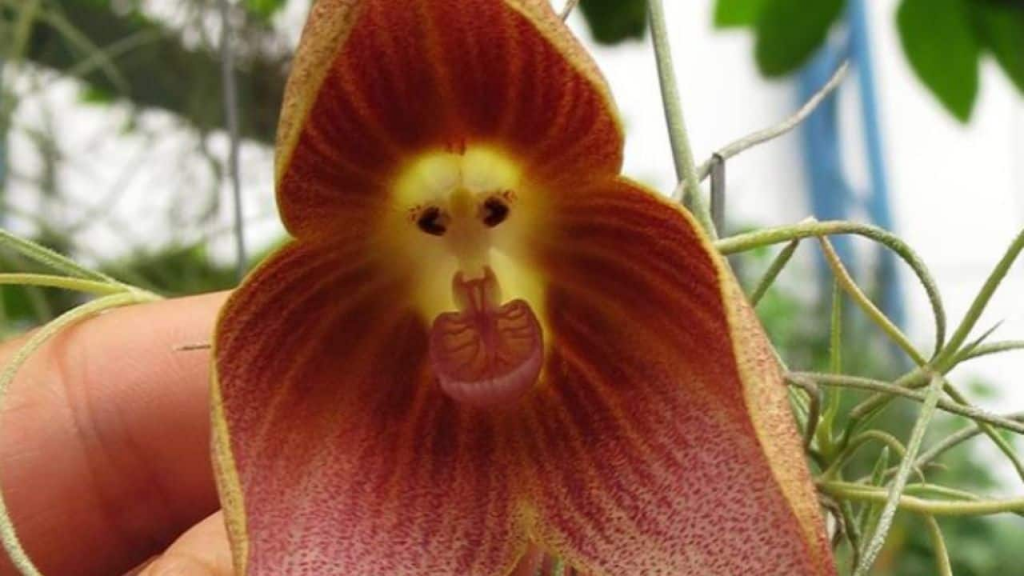
What a curious-looking, fabulous little orchid! You can see how it got its common name: its bloom perfectly mimics the shape of a monkey, limbs and all.
Native to Europe but spreading all the way to Russia in the East and Northern Africa in the South, Orchs Simia is, unfortunately, a rare and near threatened species in some countries.
Caring for your Orchis Simia
- Light and Temperature: These cuties are pretty hardy – in their natural habitat, they can be found in varying climates and altitudes. Generally, they do well in full sun to partial shade and like to be sheltered.
- Water: Like for all orchids, tap water is fine, but watering them with pure or rainwater is best. Ensure you water them regularly, especially during dry periods.
- Potting/planting: In their native environment, you’ll find Orchis Sima in woodlands, scrub, or grasslands. They like moist but well-draining soils, so a mix of chalk sand or loam soils works best. Orchis Simia can be propagated by dividing tubers towards the end of autumn.
Blooming:
The flowering season is essentially species and region-dependent, but many will flower in spring and summer.
Common Name: Vanilla Orchid
Scientific Name: Vanilla (va-NIL-lah)

Plants of the genus Vanilla are one of the few orchids that are not most commonly grown for the cut flower trade. And yes, the name gave it away; the Mexican Vanilla plant is widely commercially cultivated for its fleshy seed pods, which are essential to producing vanilla flavouring!
Caring for your Vanilla Orchid
- Light and Temperature: First up, Vanilla care is very exact and specific! Vanilla is widespread through the tropics, so it will need warm and constant temperatures as well as humidity and bright light but shaded from the sun.
- Water: It needs lots of water, good moisture and regular fertiliser. That said, that also makes it prone to rot.
- Potting/planting: You’ll need a well-draining potting mix with additional fir bark. Repot annually to keep the plant healthy.
Blooming
If you are fortunate, you might end up with a greenish-yellow Vanilla flower which will turn into a pod, But very likely, you’ll end up with no vanilla pod and potentially a massive green vine. It will be an extremely attractive vine though. It is a fantastic plant. Are you up for a challenge??
Before you go
Orchids can be such a show stopper – but beauty needs to be cared for (it doesn’t happen overnight so they say). So our team regularly gets asked about the proper care for an orchid. The most common questions are:
- Do orchids like sun or shade?
Most orchids seem to prefer a sunny spot but not direct sunlight. It is best to check the label and work with that. Light conditions will need to mimic orchids’ natural habitat.
- How do I take care of an orchid?
You will likely find the most common and easy-to-care-for varieties in your garden centre. And if you are keen to delve into more exotic varieties or rare species, there’s bound to be an orchid society in your area – or a botanical garden. They are not a plant to pot or plant and then forget about it, but if you get placement and care right, they are one of the most rewarding blooms.
- Where is the best place to place an orchid?
That depends again on the individual species. Some like constant humidity and warmth, others prefer a decent airflow. Australia is home to some stunning native orchids; recreating their natural habitat in your garden may be easier than you think!
Are you inspired yet? If you are ready to give an orchid plant a go, head over to our plants section, we’ve got your favourites in stock.
Or are you looking for a little pick-me-up without the need to nurture and repot? We’ve got some stunning colourful bouquets on offer to brighten your day.

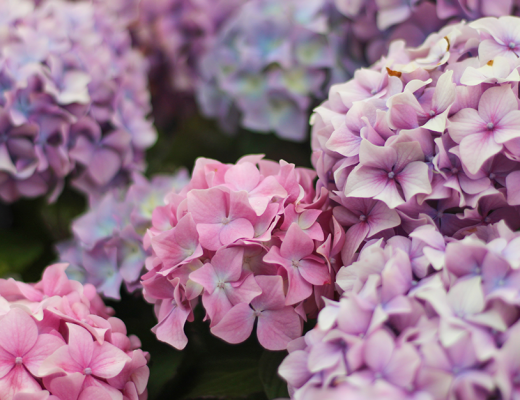
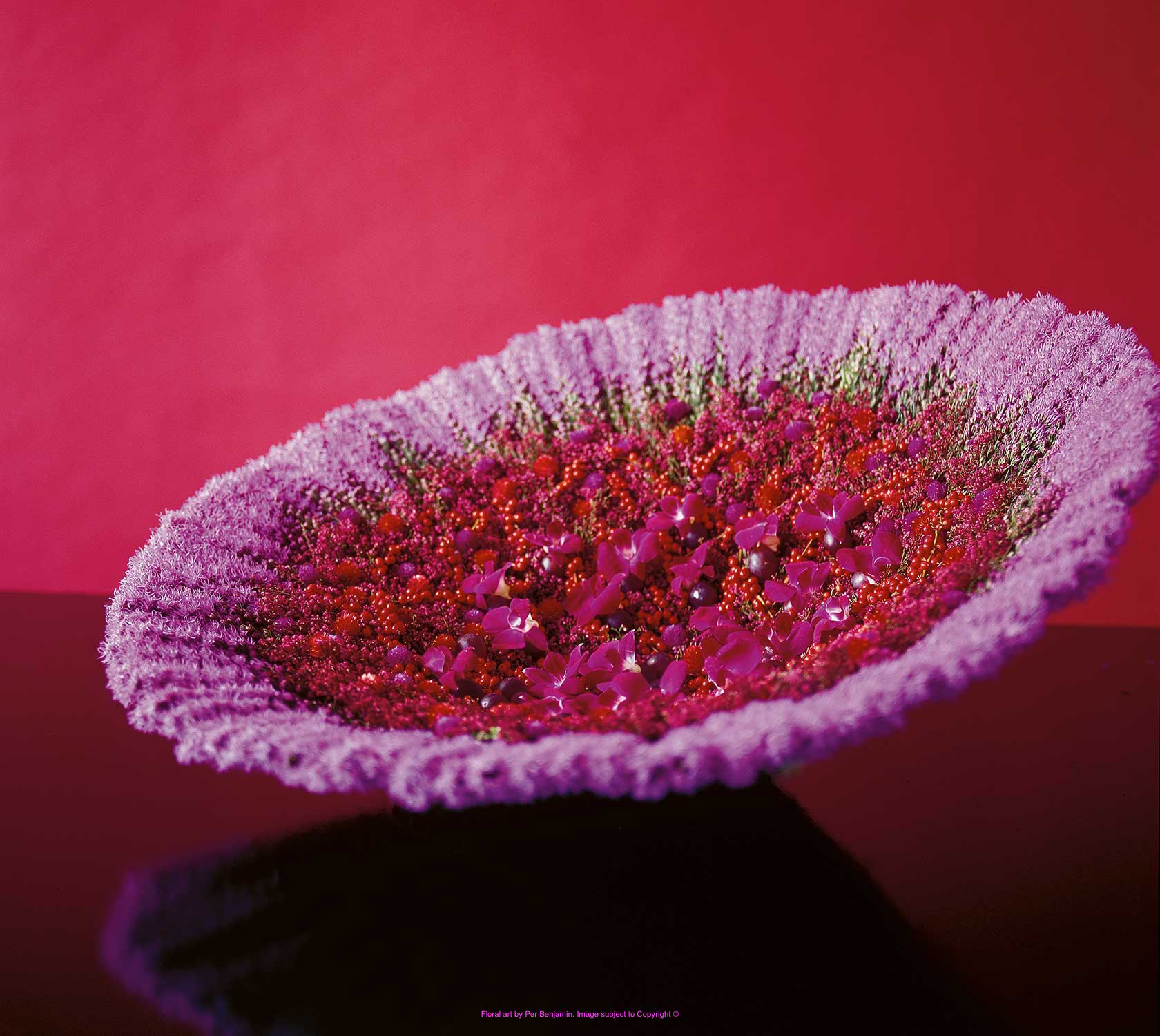

No Comments